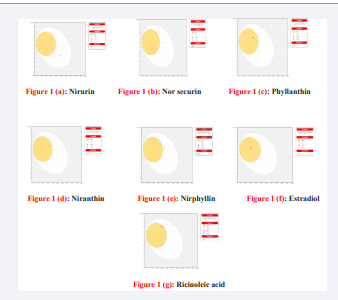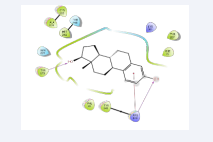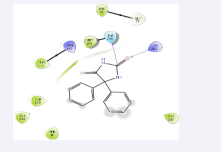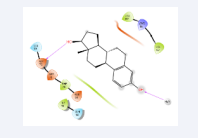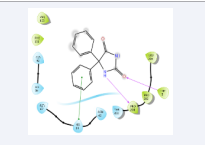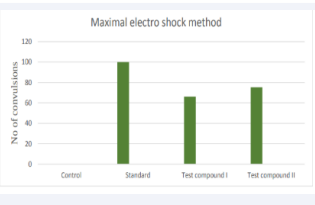Screening of Phyllanthus Niruri Leaf Phytoconstituents by Insilico and in vivo Methods for Anticonvulsant Activity
- 1. Department of Pharmacy, Institute of Pharmaceutical TechnologyIndia
Abstract
Background: In the present study, we evaluated anticonvulsant activity of Phyllanthus niruri leaves powder by Insilico and in vivo methods. A molecular docking investigation of leaf components with certain proteins associated with diseases was carried out using Schrodinger Maestro (v13.0) software.
Materials and Methods: Higher scores were also seen in the molecular docking data when compared to typical medications that are easily accessible. Invivo activity was carried out by 1 method i.e., Maximal Electroshock-Induced Convulsions.
Results and Discussion: The animals were then treated with 100mg/kg body weight i.p of Estradiol syrup formulation. According to the findings of the acute toxicity trials, estradiol was not harmful in nature on 300mg/kg concentration by showing 80% cell viability. The number of viable animals tends to decrease as the concentration of Estradiol increases.
Conclusion: Phyllanthus niruri leaves powder exhibited anticonvulsant activity in Maximal Electroshock Induced convulsion method.
Keywords
• Anti-convulsant Activity; Phyllanthus Niruri; Estradiol; Maximal Electroshock-Convulsant Method; Syrup Formulation
CITATION
Manisha P, Alekhya KP, Rajyam LL, Harishma T, Pallavi G, et al. (2023) Screening of Phyllanthus Niruri Leaf Phytoconstituents by Insilico and in vivo Methods for Anticonvulsant Activity. J Autism Epilepsy 5(1): 1017.
ABBREVIATIONS
Mg: Milligram; Kg: Kilogram; GP: Glycoprotein; BBB: Blood brain barrier; GI: Gastro Intestine; TPSA: Total Polar Surface Area.
INTRODUCTION
Chanka piedra (Phyllanthus niruri Linnaus) plant belongs to the Euphorbiaceae family. It is widespread throughout the world’s tropical and subtropical nations. This is an annual herb that is common along India’s coast. It has a very limited lifespan and has been employed in the Indian ayurvedic system for over 2000 years. The 600–700 species of the Phyllanthus genus, which includes the common field weed P. niruri, differ just a little from one another [1].
Over 450 million people worldwide, according to WHO, have at some point in their life dealt with mental, neurological, or behavioral difficulties [2]. As estimated 50 million people worldwide suffer from epilepsy with countries with lower middle incomes accounting for higher than 85% of instances [3,4]. 221 taxa from 53 plant families were included as epilepsy therapies nine of the most significant 16th and 17th century herbal treatments in Europe [5].
A typical neurological symptom of epilepsy, which is brought on by excessive and hypersynchronous electrical discharges in the brain, is recurrent, unprovoked seizures. There are numerous recognized epilepsy syndromes, each of which affects the neurological system differently and in which seizures are important phenotypic components [6]. The episodic high frequency impulse firing of a group of brain neurons, also known as focus, is linked to seizures. A local abnormal discharge that begins elsewhere in the brain may later spread there [7].
Insilico studies
ADMET properties: ADMET profiles are calculated [8], to provide a quick evaluation of a compound’s in vivo behaviour that can be used to assess its potential for use as a drug. The physicochemical properties, including the octanol/water partition coefficient (LogP), topological polar surface area (TPSA), rotatable bond count (RB), molecular hydrogen bond acceptor (HBA), hydrogen bond donor (HBD), and molecular weight (MW), were also determined using the SwissADME webserver [9].
Molinspiration: A web-based programme called Molinspiration is used to get data on variables like Milogp, TPSA (Total Polar Surface Area), the amount of rotatable bonds, drug likeness data of molecules, and drug bioactivity predictions [10].
Mlogp: It is a significant measure utilized in rational design to evaluate both molecular hydrophobicity and good permeability across the cell membrane.
Total Polar Surface Area (TPSA): It is an incredibly accurate predictor of drug transport properties including intestinal absorption, bioavailability, BBB penetration, etc. and is directly related to a molecule’s hydrogen bond potential.
Drug likeness: Drug similarity scores were computed by considering the amount of rotatable bonds, molecular weight, and heavy element count, number of hydrogen acceptors, hydrogen donors, and volume.
Molecular docking studies [11, 12]
Using a programme named Schrodinger, docking studies for anti-Parkinson’s and antioxidant activities are conducted. (Version 13.0). Less energy is needed to bind the target, the higher the negative number. Effective substances bond with less force.
MATERIALS AND METHODS
Phyllanthus niruri methanolic extract
Materials: Phyllanthus niruri leaves, methanol, Soxhlet apparatus, Wattman filter paper, Heating mantle, round bottom flask.
Plant Material: Phyllanthus niruri leaves were gathered, dried, and ground into a fine powder. The range of 45-212m (8%), 212-600m (35%), 600m-1.18mm (43%) and 1.18-3.35 (14%) is the range of the particle size distribution (%w/w) obtained by sieving.
Solvent Extraction [13]: A Whatman 25 mm by 100 mm cellulose thimble was filled with a sample of leaves weighing 25 grammes. 250ml of 90% ethanol was used as the solvent for the traditional Soxhlet procedure. The heating power was changed to two [2], cycles per hour in order to finish six [6], cycles of extraction in three hours while keeping the mantle’s temperature below 60°C. The acquired crude extract solutions were concentrated, and then it was left to air dry at room temperature. In order to reduce component damage, higher temperatures were avoided. Prior to gravimetric weighing to assess the yield, all extracts were maintained at room temperature.
Preliminary evaluation of Phyllanthus Niruri [14]
Test for Alkaloids
Dragondroff’sTest: Dragendroff’s reagent was added to the 2ml test solution. The presence of alkaloids is indicated by a reddish-brown precipitate.
Test for Glycosides
Legal’s Test: Pyridine and alkaline sodium nitroprusside were added to 2ml of test solution to produce a blood red hue.
Test for Flavonoids
Shinoda Test: A few pieces of magnesium ribbon were added to the 2 ml test solution, and then drops of conc. H2SO4 were added to it. The coloring appears pink scarlet or crimson red.
Test for Tannins: Ferric chloride test: In order to give the 2 ml test solution a blue-green hue, ferric chloride was added.
Test for Proteins and Amino
Acids Millon’s test: 2 ml of the test solution are mixed with Millon’s reagent, which forms a white precipitate that turns red when heated.
Test for Steroids
Liebermann-Burchard Test: The test solution was mixed with 3–4 drops of acetic anhydride, boiled, cooled, and 3 drops of concentrated H2SO4. At the intersection of the two layers, a brown ring develops. The presence of steroids is indicated by the upper layer turning green.
Test for Triterpenoids
Salkowski Test: A little amount of concentrated H2 SO4 (3ml) and 2ml of chloroform were added to the test solution and thoroughly mixed. Triterpenoids are present because of the reddish-brown colour that is present.
In vivo Activity
Acute Toxicity Studies [15]: Materials: 0.1% Sodium CMC.
Test compound Animals: Male wistar rats
Method: The Wistar rats utilised in this investigation weighed between 150 and 250 g when they were adults and healthy. After an overnight fast, each group’s animals are divided into one. The test chemical was administered orally in dosages of 10, 30, 100, 300, and 1000 mg/kg in CMC solution with 0.1% sodium. The only substance given to the animals in the control group was vehicle (0.1% sodium CMC). The animals were monitored for 48 hours after receiving the test drug to note any mortality.
In vivo Anticonvulsant Activity
Maximal Electroshock - Induced Convulsion [16]: The effectiveness of the test formulation’s anticonvulsant was examined using an electro-convulsometer. Six groups of healthy male Wistar rats, each weighing 150–250g, were divided after a 24-hour fast. The test formulation, suspended in sterile saline, was administered intravenously at a dose of 100 mg/kg body weight. The only treatment given to the animals in the control group was vehicle (normal saline). The test started 30 minutes after the intravenous injection. Corneal electrodes were used to deliver electrical current to the brain in order to maximize seizures. The stimulus parameter for mice was a 200 ml pulse of 50 mA given at 60 Hz. The anticonvulsant’s efficiency was compared to that of the reference drug, pheytoin (25 mg/kg), by the elimination of the tonic extensor spasm in the hind limbs.
FORMULATION [17]
Preparation of Estradiol syrup Formulation ingredients (Table 1).
Formulation methodology: Take 66.66gm of sucrose and add 30ml of distilled water to it and place them on the heating mechanical stirrer with the temperature set of 60°C for 30minutes. After vigorous stirring add 16.6mg of estradiol and glycerin to the above solution and again stirr it on the stirrer for 10minutes. Now add flavoring agent vanillin and colouring agent amaranth red and add remaining 70ml of distilled water and again set for stirring for 10ml. Now filter the 100ml solution through filter paper for any particulate matter and transfer it into a clean and neat amber colour bottle.
RESULTS AND DISCUSSION
Soxhlet Extraction
The yield of the extract after Soxhlet extraction was 3.72% (w/w), and the extracted amount was 0.93 gm.
Preliminary Phytochemical Studies
The test revealed the presence of phytochemical constituents are discussed in the Table 2.
The leaf phytoconstituents of Phyllanthus niruri plant were screened for Insilico docking studies and Invivo studies.
Insilico Studies
Molinspiration (Table 3 and 4)
A higher bioactivity score indicates a higher likelihood of being more active. Compounds with a bioactive score more than 0.00 are highly active, while those with a score between -0.50 and 0.00 are moderately active, and those with a score below -0.50 are inactive (Table 5).
The yellow portion (yolk) is for high probability of brain penetration, and the white part is for high probability of passive absorption by the gastrointestinal tract. Yolk and white regions are not incompatible. Additionally, the points are coloured red if they are projected to not be a P-gp substrate (PGP) and blue if they are predicted to be actively effluxed by P-gp (PGP+) (Figure 1-6, Table 6-11).
Figure 1: Boiled egg representation of Phyllanthus niruri leaf phytoconstituent
Figure 2: Interaction of Estradiol with interacting amino acid residues of protein 2A1H protein.
Figure 3 Interaction of Phenytoin with interacting amino acid residues of 2A1H.
Figure 4: Interaction of Estradiol with interacting amino acid residues of 3F8E protein
Figure 5: Interaction of Phenytoin with interacting amino acid residues of 3F8E protein
Figure 6: Graphical representation of Maximal electroshock method.
CONCLUSION
The aforementioned data lead us to the inference that the phytoconstituents found in Phyllanthus niruri leaves showed potential for anticonvulsant activity when tested in vivo. We also support more comprehensive ADMET and molecular docking studies, which demonstrated Estradiol’s potent anticonvulsant properties. This study may offer fresh ideas for the creation of detailed pharmacological and toxicological studies as well as for the eventual patenting of the developed formulation.
ACKNOWLEDGMENT
The administration of the IPT (Pharmacy Institute), Sri Padmavathi Mahila Visvavidyalam, Tirupati-517101, as well as the entire faculty, would want to receive particular thanks from the writers for their encouragement and technical assistance throughout the entire process.
Conflict of Interest Statement
The authors claim that the study presented in this paper was not impacted by any financial or personal conflicts that they are aware of.
